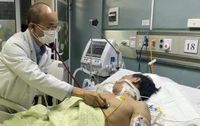As of March 22, 2025, Vietnam has seen a sharp spike in suspected measles cases, with reports indicating 42,488 suspected cases across all 63 provinces and cities since the beginning of the year. The health crisis has resulted in 4,027 confirmed cases and a tragic 5 deaths related to the virus, predominantly affecting children aged between 9 months and 15 years, with over 95% of these cases linked to individuals who were either unvaccinated or had unclear vaccination statuses.
The southern region of Vietnam is experiencing the highest incidence of these suspected measles cases, accounting for 54.9% of the total, followed by the central region at 20%, the north at 16.4%, and the Central Highlands at 8.7%. Major urban areas with high population mobility, such as Ho Chi Minh City, continue to show alarming figures. The city itself has reported 3,396 cases, alongside neighboring provinces, Dong Nai, Binh Duong, and Binh Phuoc, contributing to the death toll.
Notably, while the overall number reflects an alarming trend compared with the same period in 2024, when only 111 cases were recorded, there are indications that some areas, particularly Ha Giang and Dong Nai, are starting to stabilize. Ha Giang alone has reported 6,017 cases, reflecting the urgent need for vaccination and public health measures.
Dr. Hoang Minh Duc from the Ministry of Health indicated that although there is a trend towards a decrease in measles cases, caution is still required. "We need to maintain vigilance and continue to monitor areas with low vaccination rates and increased infection risk, particularly in mountainous regions with limited healthcare access," he said.
The Ministry of Health has launched intensive vaccination campaigns in 45 provinces, utilizing 1.5 million doses of vaccines provided by the World Health Organization (WHO) alongside municipal purchases. The vaccination initiative not only targets children from 6-9 months and 1-10 years old but also aims to identify and vaccinate unvaccinated groups that have slipped through the cracks.
Effective measures including comprehensive zoning, outbreak control, and vaccination have been emphasized to maintain the epidemic within manageable limits. The Health Department has instructed local health authorities to closely monitor the outbreak and to reassess high-risk areas frequently in collaboration with epidemiological institutes.
The ongoing measles vaccination campaign is designed to not just curb the current outbreak but also to reinforce essential immunization strategies across the country. In line with this initiative, there is a need for an efficient distribution of healthcare providers, especially in areas facing high caseloads or suspected cases.
Moreover, local authorities have been urged to implement mobile vaccination strategies and home vaccinations to ensure that children in unserved regions receive necessary health services. The commitment is to complete the measles vaccination campaign by the end of March 2025.
Dr. Duc highlighted the importance of continued public health efforts: "We must ensure the health infrastructure is prepared to handle any surges in hospital admissions, providing proper triage and infection control to minimize mortality."
The latest data emphasizes a particular focus on those with no vaccination or unclear records, as unvaccinated children are significantly more prone to contracting measles due to community spread. Furthermore, discussions around the quality of healthcare services reflect the dire need for improvement in remote and rural areas.
In addition, the Ministry of Health’s proactive strategy promotes thorough triage, efficient patient admissions, and treatment methods to provide timely interventions while also ensuring rigorous infection control in healthcare settings.
As COVID-19 has underscored the importance of vaccinations overall, the push for measles vaccination campaigns has taken on renewed urgency. The Ministry has recognized successful response plans previously adopted during COVID-19 that can be adapted for the current health crisis.
Looking ahead, the Ministry of Health continues to anticipate new measles cases and is dedicated to ongoing daily assessments of the overall epidemic landscape. It remains paramount that collaboration between regional health departments and the Ministry continues effectively to safeguard public health.
In summary, while there are glimmers of hope with stabilizing cases in certain regions, the fight against measles in Vietnam is far from over. Prompt vaccination drives, strategic public health actions, and community engagement are vital to mitigating the outbreak as authorities remain on high alert.





